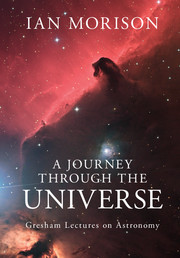Book contents
- Frontmatter
- Dedication
- Contents
- Preface
- Acknowledgements
- 1 Watchers of the skies
- 2 Our Sun
- 3 Aspects of our Solar System
- 4 The rocky planets
- 5 The hunt for Planet X
- 6 Voyages to the outer planets
- 7 Harbingers of doom
- 8 Impact!
- 9 Four hundred years of the telescope
- 10 The family of stars
- 11 Aging stars
- 12 The search for other worlds
- 13 Are we alone? The search for life beyond the Earth
- 14 Our island Universe
- 15 Wonders of the southern sky
- 16 Proving Einstein right
- 17 Black holes: no need to be afraid
- 18 It’s about time
- 19 Hubble’s heritage: the astronomer and the telescope that honours his name
- 20 The violent Universe
- 21 The invisible Universe: dark matter and dark energy
- 22 The afterglow of creation
- 23 To infinity and beyond: a view of the cosmos
- Index
- Plate section
- References
13 - Are we alone? The search for life beyond the Earth
Published online by Cambridge University Press: 05 October 2014
- Frontmatter
- Dedication
- Contents
- Preface
- Acknowledgements
- 1 Watchers of the skies
- 2 Our Sun
- 3 Aspects of our Solar System
- 4 The rocky planets
- 5 The hunt for Planet X
- 6 Voyages to the outer planets
- 7 Harbingers of doom
- 8 Impact!
- 9 Four hundred years of the telescope
- 10 The family of stars
- 11 Aging stars
- 12 The search for other worlds
- 13 Are we alone? The search for life beyond the Earth
- 14 Our island Universe
- 15 Wonders of the southern sky
- 16 Proving Einstein right
- 17 Black holes: no need to be afraid
- 18 It’s about time
- 19 Hubble’s heritage: the astronomer and the telescope that honours his name
- 20 The violent Universe
- 21 The invisible Universe: dark matter and dark energy
- 22 The afterglow of creation
- 23 To infinity and beyond: a view of the cosmos
- Index
- Plate section
- References
Summary
In Chapter 4, the search for evidence for past life on Mars was discussed and, in Chapter 6, the possibility that life might exist in the subterranean ocean on Europa was considered. In addition, perhaps surprisingly, it is not impossible that we could find evidence of life on planets that are not too far distant in the Galaxy. Over the coming years the search for extra-terrestrial planets might find somewhere that a rocky planet exists within its sun’s habitable zone and we might then sense whether life might exist there.
Let us put ourselves in the place of an advanced civilisation not too far distant in the Galaxy. Could they tell if life existed on Earth? The answer is, in fact, yes: they could, and the detection would be based on the taking of an infrared spectrum of the atmosphere of our planet. If they took spectra of Mars or Venus they would find a flat spectrum with a single deep absorption band due to the presence of carbon dioxide in the atmospheres. But that of our Earth would look very different. The presence of water vapour in our atmosphere would lower the outlying parts of the spectrum and there would be three absorption bands, not one. Along with that due to carbon dioxide, they would find a band due to methane, which would be a marker either for life (think cows) or for volcanic activity. But, more significantly, they would find a band due to ozone. Ozone can only exist in an atmosphere if there is free oxygen and, as oxygen is highly reactive, unless it is being replenished by some means, any present will soon disappear. The means by which oxygen is being replenished in our atmosphere is by the action of photosynthesis – a feature of plant life on Earth.
- Type
- Chapter
- Information
- A Journey through the UniverseGresham Lectures on Astronomy, pp. 179 - 191Publisher: Cambridge University PressPrint publication year: 2014



